

RFC 7432 - BGP MPLS-Based Ethernet VPN. Broadcom's Trident II Gets a VXLAN Booster. Draft-fang-l3vpn-virtual-ce-03 - BGP IP MPLS VPN Virtual CE. [Docs] [txt|pdf] [Tracker] [Email] [Diff1] [Diff2] [Nits] Versions: 00 01 02 03 INTERNET-DRAFT Luyuan Fang Intended Status: Standards track Microsoft Expires: January 4, 2015 John Evans David Ward Rex Fernando Cisco Ning So Vinci Systems Nabil Bitar Verizon Maria Napierala AT&T July 4, 2014 Abstract This document describes the architecture and solutions of using virtual Customer Edge (vCE) of BGP IP MPLS VPN.
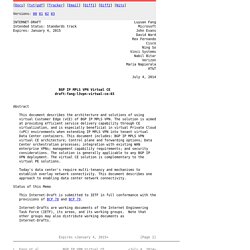
The solution is aimed at providing efficient service delivery capability through CE virtualization, and is especially beneficial in virtual Private Cloud (vPC) environments when extending IP MPLS VPN into tenant virtual Data Center containers. This document includes: BGP IP MPLS VPN virtual CE architecture; Control plane and forwarding options; Data Center orchestration processes; integration with existing WAN enterprise VPNs; management capability requirements; and security considerations. The solution is generally applicable to any BGP IP VPN deployment. L. L. L. 1. L. Generic Routing Encapsulation.
Example uses[edit] In conjunction with PPTP to create VPNs.In conjunction with IPsec VPNs to allow passing of routing information between connected networks.In mobility protocols.In A8/A10 interfaces to encapsulate IP data to/from Packet Control Function (PCF).Linux and BSD can establish ad-hoc IP over GRE tunnels which are interoperable with Cisco equipment.Distributed denial of service (DDoS) protected appliance to an unprotected endpoint.
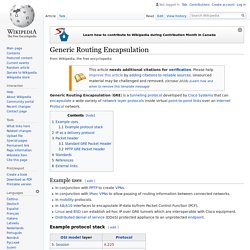
Example protocol stack[edit] Based on the principles of protocol layering in OSI, protocol encapsulation, not specifically GRE, breaks the layering order. It may be viewed as a separator between two different protocol stacks, one acting as a carrier for another. Virtual Extensible LAN. Virtual Extensible LAN (VXLAN) is a network virtualization technology that attempts to ameliorate the scalability problems associated with large cloud computing deployments.
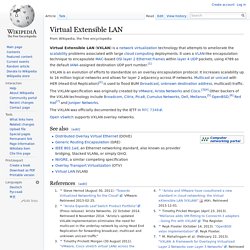
It uses a VLAN-like encapsulation technique to encapsulate MAC-based OSI layer 2 Ethernet frames within layer 4 UDP packets, using 4789 as the default IANA-assigned destination UDP port number.[1] The VXLAN specification was originally created by VMware, Arista Networks and Cisco.[3][4] Other backers of the VXLAN technology include Broadcom, Citrix, Pica8, Cumulus Networks, Dell, Mellanox,[5] OpenBSD,[6] Red Hat[7] and Juniper Networks.
The VXLAN was officially documented by the IETF in RFC 7348. Open vSwitch supports VXLAN overlay networks. EVPN Overview. An Ethernet VPN (EVPN) enables you to connect a group of dispersed customer sites using a Layer 2 virtual bridge.
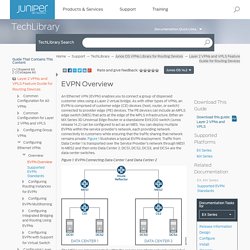
As with other types of VPNs, an EVPN is comprised of customer edge (CE) devices (host, router, or switch) connected to provider edge (PE) devices. The PE devices can include an MPLS edge switch (MES) that acts at the edge of the MPLS infrastructure. Either an MX Series 3D Universal Edge Router or a standalone EX9200 switch (Junos release 14.2) can be configured to act as an MES. You can deploy multiple EVPNs within the service provider’s network, each providing network connectivity to customers while ensuring that the traffic sharing that network remains private.
Figure 1 illustrates a typical EVPN deployment. Ethernet VPN (EVPN) and Provider Backbone Bridging-EVPN: Next Generation Solutions for MPLS-based Ethernet Services. Ethernet VPN (EVPN) and Provider Backbone Bridging EVPN (PBB-EVPN) are next generation solutions that provide Ethernet multipoint services over MPLS networks.
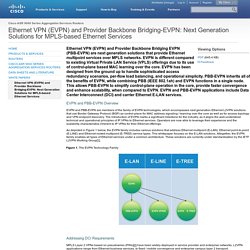
EVPN is different compared to existing Virtual Private LAN Service (VPLS) offerings due to its use of control-plane based MAC learning over the core. EVPN has been designed from the ground up to handle sophisticated access redundancy scenarios, per-flow load balancing, and operational simplicity. PBB-EVPN inherits all of the benefits of EVPN, while combining PBB (IEEE 802.1ah) and EVPN functions in a single node. This allows PBB-EVPN to simplify control-plane operation in the core, provide faster convergence and enhance scalability, when compared to EVPN.
RFC 7209 - Requirements for Ethernet VPN (EVPN) [Docs] [txt|pdf] [draft-ietf-l2vpn-...]

[Diff1] [Diff2] INFORMATIONAL Internet Engineering Task Force (IETF) A. Sajassi Request for Comments: 7209 Cisco Category: Informational R. Aggarwal ISSN: 2070-1721 Arktan J. Uttaro AT&T N. RFC 7209 Requirements for Ethernet VPN May 2014 Copyright Notice Copyright (c) 2014 IETF Trust and the persons identified as the document authors. RFC 7348 - Virtual eXtensible Local Area Network (VXLAN): A Framework for Overlaying Virtualized Layer 2 Networks over Layer 3 Networks. [Docs] [txt|pdf] [draft-mahalingam-...]

[Diff1] [Diff2] INFORMATIONAL Independent Submission M. Mahalingam Request for Comments: 7348 Storvisor Category: Informational D. Dutt ISSN: 2070-1721 Cumulus Networks K. Duda Arista P. RFC 7348 VXLAN August 2014 Copyright Notice Copyright (c) 2014 IETF Trust and the persons identified as the document authors. RFC 7348 VXLAN August 2014 1. Server virtualization has placed increased demands on the physical network infrastructure. RFC 7348 VXLAN August 2014 1.1. How data center network fabric and SDN intersect. What is the relationship between data center network fabric and software-defined networking?
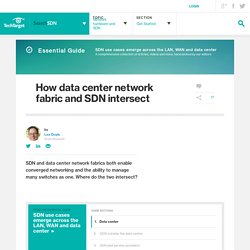
The question will... become increasingly relevant as engineers begin using SDN and network fabrics for scalability and manageability in high performance data centers. But vendors will offer divergent strategies in which SDN and network fabrics are either totally interdependent or largely independent of each other. Users will have to determine which strategy works for them. SDN and network fabrics: Similar roles in the data center? Network fabrics are defined as high-performance, low-latency, scalable Ethernet switching products that connect compute, storage and software elements in a converged network. SDN, on the other hand, provides a software abstraction of the physical network that allows the network to be programmable and specifically tied to the needs of applications.
The downsides of a software-defined infrastructure. The data center of the future could lead to a software-defined infrastructure, but current technology is still...

By submitting your personal information, you agree to receive emails regarding relevant products and special offers from TechTarget and its partners. You also agree that your personal information may be transferred and processed in the United States, and that you have read and agree to the Terms of Use and the Privacy Policy. relatively immature, with more work needed in the area of automation. Eric Hanselman, research director for networking at 451 Research in Boston, agrees that the software-defined data center (SDDC) is about improving integration, as well as about automation. The goal is to take activities that often involve physical changes and manual processes, and integrate them with other, more automated data center practices, he said.
An SDDC's primary goal is to make it easier to change server, storage and in particular, network configurations. Using SDN switches to flexibly scale data center networks. Researchers at the University of Illinois at Urbana-Champaign's Ocean Cluster for Experimental Architectures in...
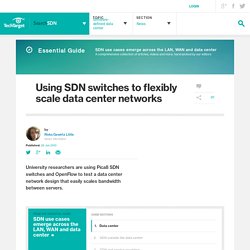
Networks are using SDN switches to test a new data center network architecture that incrementally scales bandwidth between servers without a significant hardware investment. Ocean has installed 13 Pica8 SDN switches with a total of 670 ports that will be "sliced up" to emulate a much greater volume of smaller switches. These switches will act as a large data center network to form a test bed for a wide range of SDN applications, said Brighten Godfrey, an assistant professor of computer science at the university. Ocean is testing an entirely new approach to designing and scaling data center networks, as well as a configuration management and monitoring tool that verifies instructions being sent from centralized OpenFlow controllers actually work. OpenFlow switches support routing in a new network architecture.
Virtual overlay networks: Tunneling protocols enable multi-tenancy. Virtual overlay networks have taken center stage as data center managers seek networking solutions that better... support VM provisioning, enable scalability and improve automation. A virtual overlay network -- one form of network virtualization -- uses tunneling protocols to form paths between software-based network agents in hypervisors running on servers.
Virtual overlay network software separates the virtual network from the underlying physical network hardware, enabling provisioning of virtual networks and accompanying services between servers in the data center. This means that virtual networks can be spun up on demand to support specific virtual workloads, for example. Is an open source network virtualization platform for the cloud. – Architecture Documentation. This chapter provides an overview of the OpenContrail System – an extensible platform for Software Defined Networking (SDN). All of the main concepts are briefly introduced in this chapter and described in more detail in the remainder of this document.
OpenContrail is an extensible system that can be used for multiple networking use cases but there are two primary drivers of the architecture: The Private Cloud, the Virtual Private Cloud (VPC), and the Infrastructure as a Service (IaaS) use cases all involve a multi-tenant virtualized data centers. In each of these use cases multiple tenants in a data center share the same physical resources (physical servers, physical storage, physical network). Rfc7364.txt.pdf.
Rfc7365.txt.pdf. Network Virtualization Overlays (nvo3) - Documents.